

Mellor, "Problems of Perception" Problems of Perception Anne K.
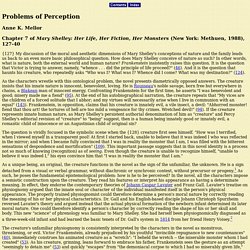
Mellor, "Usurping the Female" Usurping the Female Anne K.

Mellor Chapter 6 of Mary Shelley: Her Life, Her Fiction, Her Monsters (New York: Methuen, 1988), pp. 115-26 {115} In constituting nature as female -- "I pursued nature to her hiding places" (49) -- Victor Frankenstein participates in a gendered construction of the universe whose negative ramifications are everywhere apparent in the novel.
The uninhibited scientific penetration and technological exploitation of female nature is only one dimension of a patriarchal encoding of the female as passive and possessable, the willing receptacle of male desire. A Cultural History of Frankenstein: Curiosity and Gender. Passion and curiosity: two things that women of the 19th century were feared to possess.
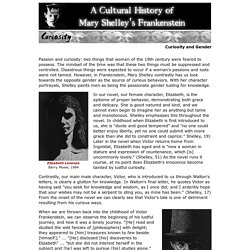
The mindset of the time was that these two things must be suppressed and controlled. Disastrous things were expected to occur if a woman's passions and lusts were not tamed. However, in Frankenstein, Mary Shelley contrastly has us look towards the opposite gender as the source of curious behaviors. With her character portrayals, Shelley paints men as being the passionate gender lusting for knowledge. Contrastly, our main male character, Victor, who is introduced to us through Walton's letters, is clearly a glutton for knowledge. Victor's intoxication with the knowledge he is now possesses soon turns to terror when he finally sees the fruits of his labor. Jessica Hale. Oates, "Frankenstein's Fallen Angel" Mellor, "Problems of Perception" Hogle, "Otherness in Frankenstein"
Otherness in Frankenstein: The Confinement/Autonomy of Fabrication Jerrold E.
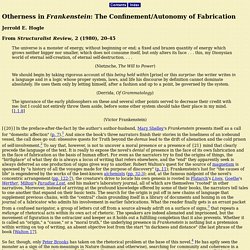
Hogle From Structuralist Review, 2 (1980), 20-45 The universe is a monster of energy, without beginning or end; a fixed and brazen quantity of energy which grows neither bigger nor smaller, which does not consume itself, but only alters its face . . . this, my Dionysian world of eternal self-creation, of eternal self-destruction. . . . (Nietzsche, The Will to Power) We should begin by taking rigorous account of this being held within [prise] or this surprise: the writer writes in a language and in a logic whose proper system, laws, and life his discourse by definition cannot dominate absolutely.
The ignorance of the early philosophers on these and several other points served to decrease their credit with me: but I could not entirely throw them aside, before some other system should take their place in my mind. [1.1.8](Victor Frankenstein) I saw Elizabeth [his fiancée] walking in the streets of Ingolstadt. Notes 1. 440 1556 1 SM. Lamb, "Frankenstein and Milton's Monstrous Myth" Hetherington, "Creator and Created in Frankenstein" Creator and Created in Mary Shelley's Frankenstein Naomi Hetherington Keats-Shelley Review 11 (1997): 1-39. {1} Mary Wollstonecraft Shelley began writing Frankenstein in the summer of 1816 when she was just nineteen years old.1 It is a tale so over-powered with sources and origins that it has gained a reputation in literary circles as 'the most protean and disputable of even Romantic texts'.2 Mary herself suggested several keys with which to unlock it.
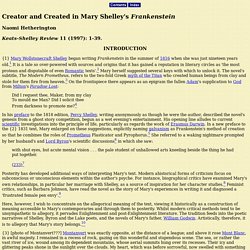
The novel's subtitle, The Modern Prometheus, refers to the two-fold Greek myth of the Titan who created human beings from clay and stole for them fire from heaven.3 On the frontispiece there appears as an epigram the fallen Adam's supplication to God from Milton's Paradise Lost: Did I request thee, Maker, from my clay To mould me Man? In his preface to the 1818 edition, Percy Shelley, writing anonymously as though he were the author, described the novel's genesis from a ghost story competition, begun as a wet evening's entertainment. Monster of Theory: The “Quest” for Mythology and Archetypes in Frankenstein.
Northrop Frye concedes in The Archetypes of Literature that his tables of archetypes are “not only elementary but grossly over-simplified” (1315), but these tables can still be of use in analyzing Shelley’s Frankenstein.
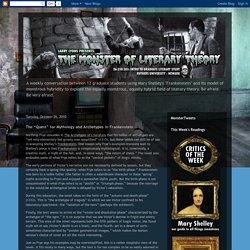
One reason why Frye’s examples translate well to Shelley’s piece is that Frankenstein is conspicuously mythological. An Essay Concerning Human Understanding - Wikipedia. An Essay Concerning Human Understanding is a work by John Locke concerning the foundation of human knowledge and understanding.
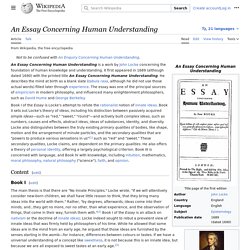
It first appeared in 1689 (although dated 1690) with the printed title An Essay Concerning Humane Understanding. He describes the mind at birth as a blank slate (tabula rasa, although he did not use those actual words) filled later through experience. An Essay Concerning Human Understanding - Wikipedia. Romanticism. Mary Shelley's Frankenstein. A selective list of online literary criticism for Mary Shelley's Frankenstein, favoring signed articles by recognized scholars, articles published in reviewed sources, and web sites that adhere to the Modern Language Association Guidelines for Authors of Web Pages Main Page | 19th-Century Literature | 19th-Century Novel | About LiteraryHistory.com Anderson, Robert.

Anderson considers theories of work and leisure time in Frankenstein. "'Alternate Labour and Relaxation': An Introduction," issues of labor and leisure in Frankenstein. Romanticism on the Net 27 (2002). Anderson, Robert W. Austin, Andrea. Cantor, "The Nightmare of Romantic Idealism" The Nightmare of Romantic Idealism Chapter 3 of Creature and Creator: Myth-Making and English Romanticism (Cambridge and New York: Cambridge Univ.
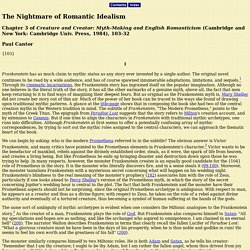
Press, 1984), 103-32 Paul Cantor Frankenstein has as much claim to mythic status as any story ever invented by a single author. The original novel continues to be read by a wide audience, and has of course spawned innumerable adaptations, imitations, and sequels.1 Through its cinematic incarnations, the Frankenstein story has ingrained itself on the popular imagination.
We can begin by asking: who is the modern Prometheus referred to in the subtitle? The same sort of ambiguity of mythic archetypes is evident when one considers the Miltonic analogues to the Frankenstein story.3 As the creator of a man, Frankenstein plays the role of God. The monster similarly compares himself to two Miltonic roles. I often referred the several situations, as their similarity struck me, to my own. Frankenstein.